During a recent series of email exchanges, the subject turned to the question of the ideal size and resolution for biodiversity images. The suggestion was made that our goal should always be to capture the very highest possible resolution – and hence largest – images, using the best technology available.
As someone who is involved in producing reference images to support pest diagnosis and biodiversity research (see PaDIL), I certainly have a daily focus on producing the best images possible. In a sense, therefore, I certainly agree with my correspondent that, “spending the effort to capture good images at a high quality makes them much more useful to a greater audience”. Ideally, all images for virtual diagnostics would be prepared by highly trained specialists with unlimited time using cutting edge technology.
However I believe it is essential for us to balance this view. Lower-quality images are frequently perfectly adequate to tell us what we need. We usually make do with ‘good enough’ – and usually ‘good enough’ gets the job done. Understanding the difficulties that most people (scientists and citizen scientists) have in creating high quality images, we should not set too high a standard for the user to submit material. I’d like to illustrate this with an example.
I recently received the mite image below. For the entomologist in a New Guinea village who took this image, the limiting factor was not time and skill but rather equipment.
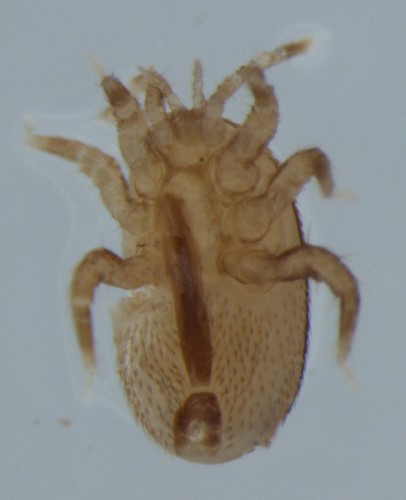
My correspondent worried that such an image might be of little use to a mite expert, but I would be very concerned if such a person was unable at least to make a tentative ID from what was supplied.
What was supplied included not only the photo but also metadata for the image. That metadata was location: New Guinea; and Host: Apis mellifera.
Now there are only two genera of mites that attack Apis and which are of biosecurity concern to Australia, or indeed to SE Asia: Varroa and Tropilaelaps. One is oval in shape and one is elongate:
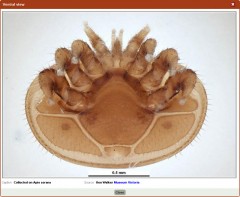
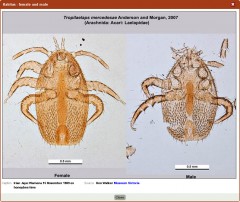
When Denis Anderson recently revised and described new species in the mite genus Tropilaelaps, I contacted him and asked for reference material to be image captured for PADIL.
He sent me all of the type slides, along with specimens preserved in OH, explained to me what diagnostic images to capture, and wrote diagnostics notes for each species. So I captured images of all four known species and put them on PaDIL with in incredible amount of detail.
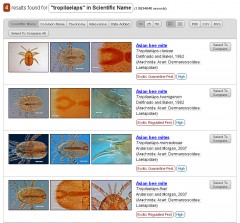
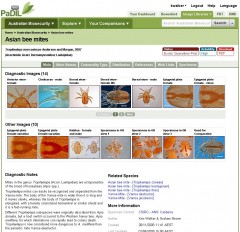
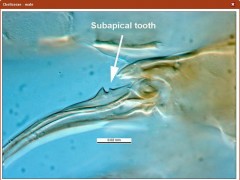
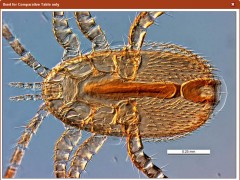
I did “[spend] the effort to capture good images at a high quality [to] make them much more useful to a greater audience”, but I have always remembered the lessons I learned by talking to the users of such images – biosecurity diagnosticians.
I clearly remember having a discussion with some diagnosticians about a new high-quality taxonomic publication which included wonderful scanning electron micrographs (SEMs) showing diagnostic features in high detail. I assumed this book would be enormously useful to them, but they resoundingly replied that they hated it! The reason was that ” it is not what we see under the microscope”. I have never forgotten that lesson and I have endeavoured to take images that resemble what you see under a microscope.
The above image is the “perfect” ventral image for that species. Denis has done a wonderful job of preparing and slide mounting the specimen. I have used a $50,000+ Leica DM500 compound microscope with DIC (differential interference contrast) lightening regime and the single image is a montage of about 10 originals. And the image can be zoomified. What more could you possibly want?
Well, I also took images of unmounted specimens in OH and images of known intraspecific variation. And believe it or not, I was told that the OH images were more useful than the slide mounted images.
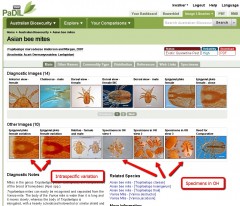
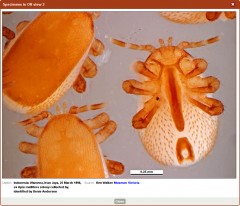
They clearly show the modified forelegs and the spanner like ventral and genitalia armature. The males have a space while there is no space in females
Which image do you think is more useful to the entomologist in a New Guinea village when looking down the microscope at a non-slide mounted specimen?
I intend to add these images to the PaDIL page to provide users with as many different views of the same animal.
So what’s the point of this?
We need to consider the likely users of our images. Sophisticated diagnostic images are very important – they help us to determine authoritatively whether a specimen does indeed belong to a particular species. However there is also an important role for images that show just how an organism looks to a normal observer, both in life as a dead specimen. For field observations, rough and ready images are likely to be the norm, but may be fully adequate to prove that the species has indeed been found at a particular time and place. All of these images can contribute in different ways to furthering our understanding of Australian biodiversity.